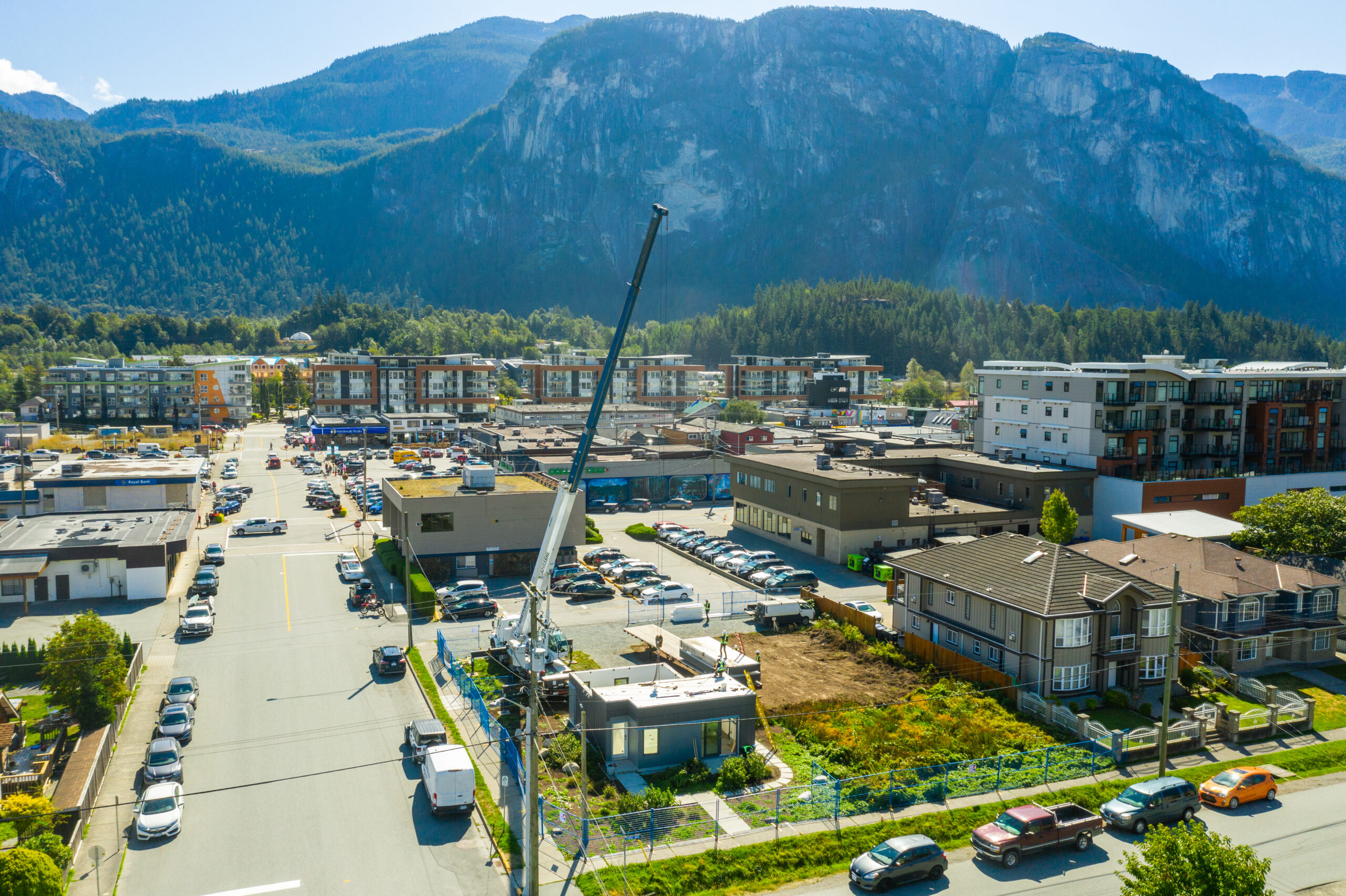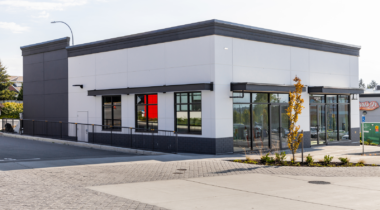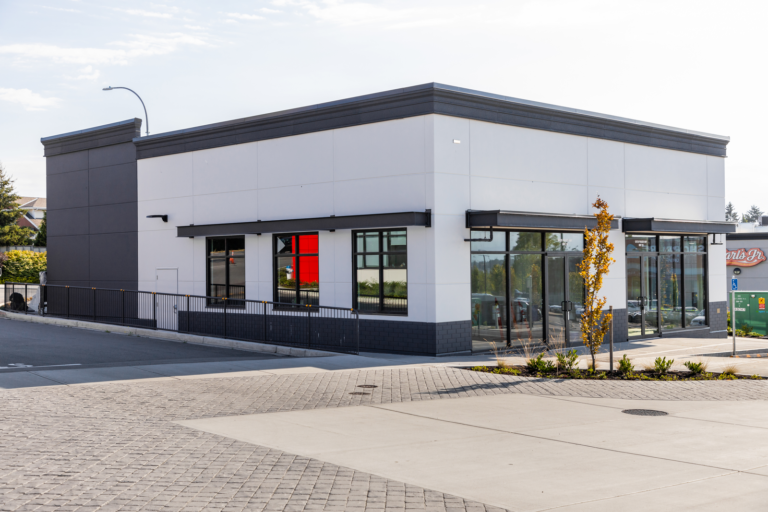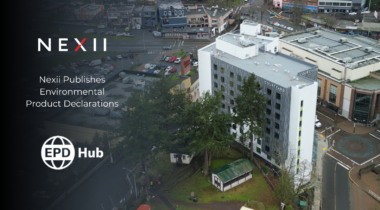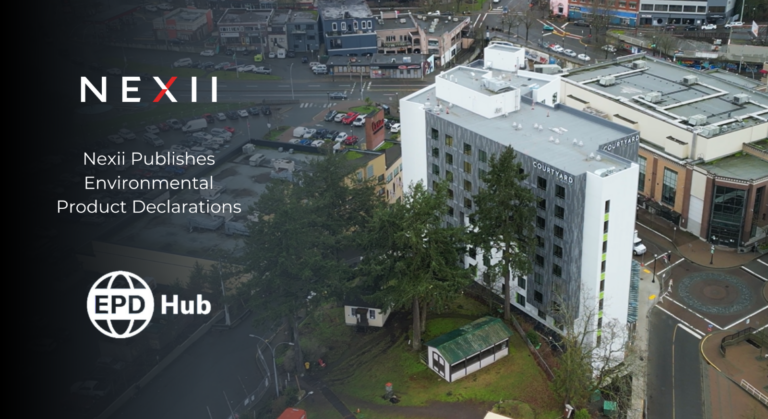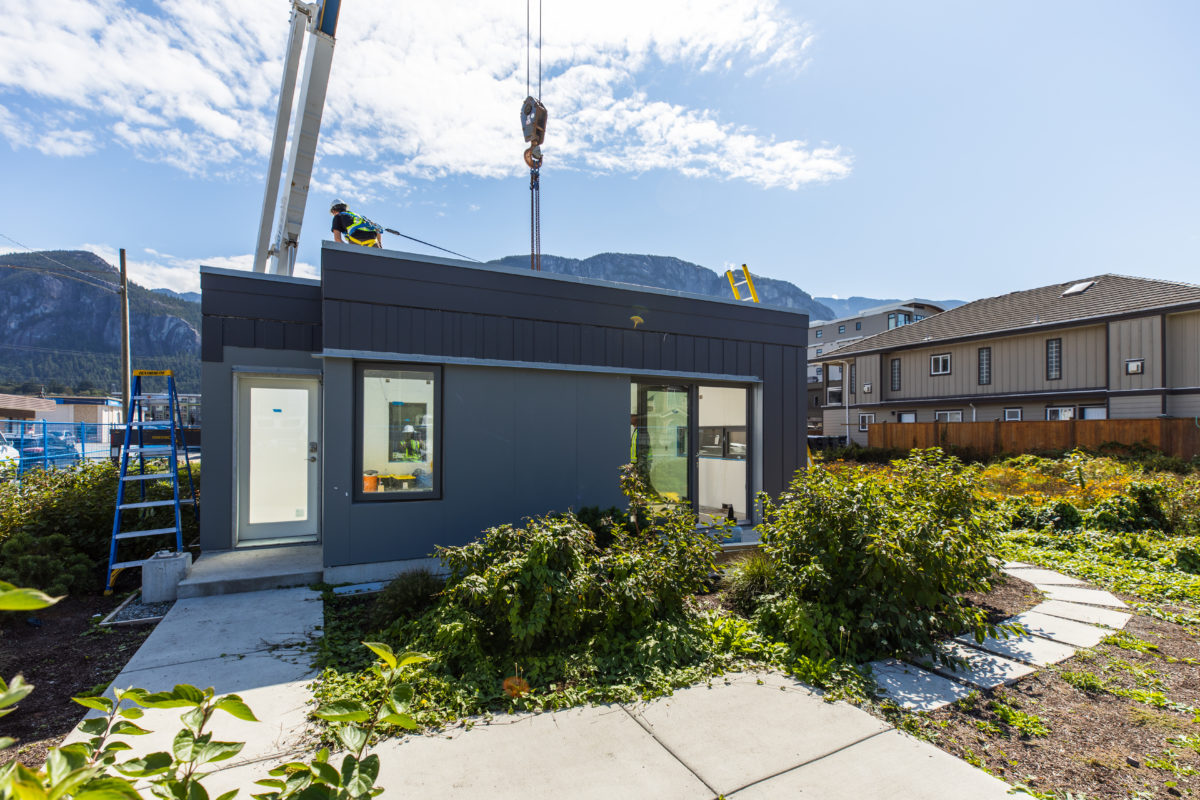
Zosia Brown, PhD, is Nexii’s Vice President, Sustainability. Her notable past roles include Head of Sustainability at Woodland Park Zoo, WA, and Associate with Buro Happold.
Zosia’s PhD in Resource Management Environmental Studies focused on green building performance and post-occupancy evaluation. She brings over 15 years’ experience in driving sustainable change and environmental policy in organizations across North America and Europe to Nexii. Zosia’s deep and consistent focus on product performance, carbon impact of operations, zero waste and climate resilience are at the heart of Nexii’s operations. Together with teams from across the company, Zosia leads Nexii’s environment, social and governance (ESG) strategy underpinning our mission to build a vibrant future for people and planet.
In my previous blog, I discussed the circular economy, describing the significant impacts of the current linear approach to buildings and construction on the environment and the opportunities for circularity. In this blog, I share findings from Nexii’s Deconstruction Case Study, demonstrating the power of repurposing buildings versus the impacts of standard building demolition.
This case study specifically compares the disassembly of a Squamish-based Nexii commercial building with the demolition of wood frame and steel stud building baselines. It was developed in partnership with Light House Sustainability Society (Light House), an environmental non-profit, with added support from PICS and input from the District of Squamish. You can access the full case study here.
Deconstruction Case Study
Nexii’s Deconstruction Case Study assesses the waste and embodied carbon impacts of a Nexii building compared to conventional construction. The 700 square foot Discovery Centre was built as a demonstration project for Nexii, 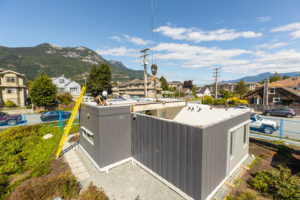 manufactured in our Moose Jaw plant and assembled in Squamish, B.C. in 2019. It was disassembled in September 2021, over a period of six days, and will be reassembled as a laneway house on Saltspring Island, B.C.
manufactured in our Moose Jaw plant and assembled in Squamish, B.C. in 2019. It was disassembled in September 2021, over a period of six days, and will be reassembled as a laneway house on Saltspring Island, B.C.
Nexii’s Deconstruction Case Study models true circularity in the built environment, illustrating the opportunities and advantages, as well as challenges around design for deconstruction. Design for Deconstruction (or Design for Disassembly) refers to buildings that can be dismantled at the end of their service life and reused in whole or in part or separated into constituencies for material recovery and value retention.
Not all modular buildings can be easily disassembled at their end-of-life. From the start, Nexii has invested research and development into a panelized construction system that will allow for disassembly and reassembly of building panels. Key design features of this system include:
- Panelized wall assembly to increase feasibility of disconnection and re-assembly
- The use of durable materials, like Nexiite, that withstand deconstruction processes
- Access to bolt connections for panels with a view to standardized design for future compatibility
- Consideration of renewal cycles between panel components and layers
- Ease of access and maintenance of mechanical, electrical, and plumbing (MEP) systems
- Labeling and cataloguing records of panels to provide key information to teams in the future
The Discovery Centre Disassembly
At the end of the Nexii Discovery Centre’s use in its Squamish location, the building was deconstructed into its component panels to be reassembled on a new site. Because its deconstruction was considered during design using DfD strategies, the disassembly was simple and on schedule, taking 6 days in total. The blueprint for installation became the plan for disassembly when reversed:
- The team started with the removal of the interior of the building, including the mechanical and electrical systems.
- Then, the team could begin with the panel disassembly, starting with the roof.
- The windows and doors were protected and secured for transport so that the wall panels could be removed and flat packed for transportation.
- Finally, the floor panels were removed, leaving the foundation intact.
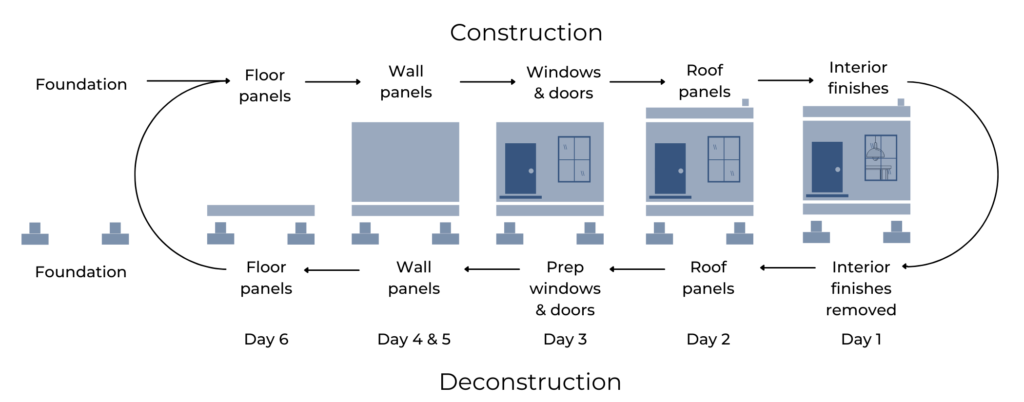
Design for Deconstruction Case Study Results
Waste Diversion
The Discovery Centre has a high diversion from landfill rate with the reuse of the building panels and the interior totalling 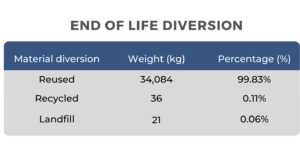 99.83% reuse of materials in all. Materials such as EPS scraps and metal flashing were recycled (0.11%). Only 0.06% of the materials ended up in the landfill, amounting to approximately 2 small buckets of waste. This consisted of sealant that was scraped from the panels as well as other miscellaneous items that were not able to be recycled. A detailed breakdown of end-of-life building materials waste diversion is included in the full case study.
99.83% reuse of materials in all. Materials such as EPS scraps and metal flashing were recycled (0.11%). Only 0.06% of the materials ended up in the landfill, amounting to approximately 2 small buckets of waste. This consisted of sealant that was scraped from the panels as well as other miscellaneous items that were not able to be recycled. A detailed breakdown of end-of-life building materials waste diversion is included in the full case study.
Embodied Carbon
A Life Cycle Assessment (LCA) was conducted to compare the environmental impacts of the Discovery Centre compared to conventional construction designs (wood and steel-framed buildings). The Steel and Wood Stud designs were based on designs for typical buildings meeting equivalent thermal and structural performance requirements. The system boundaries defined in this assessment include information modules A to D, in other words cradle-to-cradle.
At the time of the disassembly, the site owner intended to reuse the concrete foundation, however this was later demolished  to return the land to its original state. The LCA compared embodied carbon impacts between the three designs, with and without foundation reuse.
to return the land to its original state. The LCA compared embodied carbon impacts between the three designs, with and without foundation reuse.
Design for Deconstruction, or the ability to disassemble the Nexii panels intact, ready to be installed in a new location, offset 68% of the embodied carbon associated with the panel manufacturing. This number increases to 96% with foundation re-use on-site. This is largely a result of the significant CO2e emissions savings in material manufacturing for the next use of the panels, in addition to waste disposal savings. When considering modules A to D relating to embodied impacts, the Nexii design has a 34% and 47% lower Net GWP impact than the Wood and Steel Stud designs,  respectively, or 81% and 88% lower Net GWP impact with foundation reuse on-site. The highest and best use of the concrete foundation for this project is on-site reuse, however foundations are more typically crushed and the rubble reused as aggregate or landfilled. Applying DfD principles to concrete building foundations remains a gap in most circular design case studies from across the industry.
respectively, or 81% and 88% lower Net GWP impact with foundation reuse on-site. The highest and best use of the concrete foundation for this project is on-site reuse, however foundations are more typically crushed and the rubble reused as aggregate or landfilled. Applying DfD principles to concrete building foundations remains a gap in most circular design case studies from across the industry.
Community Benefits
Site Disturbance: In the Nexii disassembly, a single, stationary crane was used to access exterior walls and roofs, minimizing site disturbance. This contrasts with traditional demolition methods where construction vehicles and heavy machinery move over the entire site, and are often stored for longer periods of time. Nexii’s approach reduces soil compaction, erosion and vegetation disturbance with benefits for neighbouring waterways.
Health and Wellbeing: The virtual elimination of airborne contaminants during deconstruction, and the reduction of noise over a harmful decibel level contribute to the health and wellbeing of the deconstruction workers, as well as others who are proximal to the site. The reduced physical demands as compared to other types of deconstruction helps to protect workers from injury and potentially extend their careers.
Time & Jobs: Perhaps the greatest economic benefit observed is that the design for disassembly process shifts investment from material to people. During the Nexii disassembly three people were employed over six days[1] compared to a demolition project where one to two people are employed for three to five days for a typical size project. Rather than purchasing new resource-intensive materials, that money goes towards labor, boosting the local economy and creating jobs. Over 350 employment hours were created during this project, including Nexii staff.
Key Learnings
A few key learnings were identified in the deconstruction process that are being embedded into future Nexii processes:
Panel labeling system: When Nexii panels are built, they are identified with standard labels before being transported to the site and assembled. The labels include a unique panel identification number, the type of panel (roof, wall, floor), the size and weight. These labels are located on the edges of the panels and therefore embedded within the wall during assembly. Disassembly revealed that, although the labels were legible, they were not in perfect condition and label durability could be improved going forward.
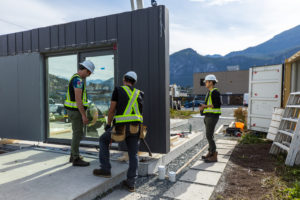
Storage: Planning for storage of panels (if necessary), determining ownership, the overall process for panel assessment, remediation for reuse, and timing of panel readiness around future site permitting and preparation must take place at the outset of a project.
Insurance: In contrast to a demolition project, additional insurance is needed for panels during end-of-life and next-life stages, including disassembly, remediation, transportation, and reassembly. Establishing who will cover the insurance at each stage is an important step.
Quality Control: Inspection of disassembled panels is required to ensure the panels are in good shape before reinstallation. Preparation for the panels to be reinstalled at the new site is likely to include painting, relabelling, and scraping of sealants from the panels to allow for proper reassembly. Sealant was one of the few materials that was landfilled from the disassembly of the Discovery Centre. As Nexii moves its sealant system towards dry seals, this will further reduce the amount of waste.
Reassembly: The potential limitations of the site where the panels will be reassembled must be understood to address any transportation, unloading and assembly constraints. This differs from new construction where prefabricated panels can be sized to suit the project and site.
Conclusion
The Nexii Deconstruction Case Study identifies several significant advantages of the Design for Disassembly model, including waste reduction, avoidance of new material use, improved wellness of construction workers and employment generation. This case study illustrates that it is possible to shift towards deconstructing our built environment to create a system where the long-term sustainability of resource use can be prioritized without compromising quality, incurring additional costs, or sacrificing jobs. This strategy is part of how to create a regenerative and circular built environment.
Contact us to find out more about how Nexii’s building solution can support your future projects.
[1] Hours logged by Nexii team
